|
Edited by Frank R. Shaw, FSA Scot, Greater Atlanta, GA, USA
Email: jurascot@earthlink.net
My good friend Patrick Scott, retired
professor at the University of South Carolina, has a way of writing
articles that show up like gifts under a Christmas tree, but there is
one huge difference - his gifts show up more than once a year! Such is
the case with this article on the Bard that will bring you joy and
tickle your heart. I could write much more on Patrick, his adventures
and publications, but all I need do is refer you to the many articles in
the Robert Burns Lives! index he has posted over the years. Take your
pick of them or read them all and you will be a better person for
learning about this amazing husband, father, grandfather, scholar,
teacher, professor, author, and noted speaker, the many shoes he has
filled over his career. You are a lucky person indeed if he is listed
among your friends. Enjoy this article and know there will be others
from this gifted and talented writer in the future. (FRS: 7.10.20)
Reading Burns in Installments: the Hidden
History of Part-Publication
By Patrick Scott
About a year ago now, an old friend, a very
knowledgeable antiquarian bookseller, emailed me about a rare Burns
item:
I attach a description of a
set of the works of Robert Burns, issued in 17 parts or fascicles. Although
I have probably seen more sets of Burns’s works than I have had hot dinners,
I have never encountered a set issued in parts. Nor could I find a bound set
made up from these parts. Egerer’s bibliography of Burns has remained
reasonably reliable over the years, but this also seems to have been a copy
or set that he missed.
The dealer had done his due diligence: this
particular set (which he identified as the “People’s Edition,” published
by Virtue of London, ca. 1910) is indeed unrecorded elsewhere. Because
standard library cataloguing relies on title-page information, total
page numbers, and size, the major online catalogues do not usually tell
you which libraries might have a Burns edition issued in parts rather
than as a bound volume. And, with only a few exceptions, J. W. Egerer’s
standard Burns bibliography does not usually record if an edition was
ever issued in separate parts.
While it is by no means implausible that a dealer at the upper end of
the book market had never encountered Burns-in-parts, this publication
pattern was quite widely adopted throughout the nineteenth century. The
most famous example is the novels of Charles Dickens, beginning with
Pickwick Papers (1836-1837). Partly because of other Burns projects,
discussed below, I’d recently come across two other sets of
Burns-in-parts, and the email made me look for more.
Publication in parts broadened the market, by allowing people with
modest disposable income to buy expensive editions installment by
installment, spreading the cost over a period of up to two years. Even
white-collar workers in the late Victorian period might earn only five
or six pounds a month (a hundred shillings, “thirty bob a week”). A book
that might cost perhaps thirty shillings, or even two pounds, in
complete form, was much more affordable when purchased part by part,
month by month, maybe in 8 thick parts at five shillings each, or in
fifteen parts at two shillings, or maybe in 25 magazine-like parts for
one shilling a month.
The problem for collectors is that, once a purchaser had completed the
set, the parts would normally be bound up in book form. Separate parts
in paper covers are easily damaged, and libraries either sent the parts
for binding, when the covers themselves would usually be discarded, or
eventually had to discard the parts themselves. If a set was incomplete,
or some issues got damaged, the likelihood of the remaining parts being
preserved is very low—individual parts, like old magazines, tend to be
kept for a while, and then thrown out. If the odd wrappered part got
saved as a curiosity or collectible, you are more likely to find it now
in a junk shop or on eBay than in an antiquarian bookstore, and such
separate parts are easy to cannibalize, because the illustrations can be
framed or sold separately. Very few complete sets of Burns-in-parts seem
to survive, or at least very few seem to be recorded in libraries. This
brief survey, based on material in the Roy Collection, is intended to
give a general overview, but it will inevitably be selective and
incomplete. There must, however, be individual parts, or even complete
sets, lurking unregarded in the personal collections of some longtime
Burnsians and Burns collectors, and if so, I’d be pleased to hear from
them.
Publishing in parts did not originate with the Victorians. It was used
in the 18th century for expensive illustrated works, like Francis
Grose’s Antiquities of Scotland. Bill Dawson pointed out a few years ago
that the first publication of Burns’s “Tam o’ Shanter,” in 1791, in
Grose’s second volume, had always been misdated. Burns scholars had been
using the date when Grose’s completed volume was advertised, in April
1791, citing the poem as first published in March in an Edinburgh
newspaper, but the part of the Antiquities with “Tam o’ Shanter” had
appeared at least two months earlier, perhaps more (Dawson).
Booksellers also used part-publication at the other end of the market.
The earliest part-issue of Burns in the Roy Collection is a little
duodecimo printed in Paisley by J. Neilson, in 1801-1802. Ross Roy liked
to recount how he bought it in the Gorbals many years ago for thirty
shillings (i.e. £1.50: Roy and Scott, 2010). Each of the 36-page
sections or gatherings of the book has been put into its own plain paper
wrapper, and when the buyer stitched them roughly together in two
volumes, he left these temporary wrappers intact. There are no separate
title-pages for the parts: each part ends or takes up abruptly wherever
the page ends, even in the middle of a poem. Without external evidence,
it’s impossible to prove this edition was sold in separate parts, but
there seems no other explanation for the separate paper wrappers (cf.
Sudduth, p. 43).
This was not a unique example. Egerer notes an edition published in
Newcastle in 1818 as being issued in parts, and that four parts, from at
least twenty-six, survive in the Mitchell Library collection (Egerer,
209, p. 134, though the part issue is not noted in Fisher, p. 65). The
bound volume of this edition in the Roy Collection, like the one Egerer
describes in the Carnegie Library, Ayr, had been bound up from the
separate parts, with the stab holes still visible in the inner margins
(as described further below).
Part-issue not only spread the cost for the buyer, but also spread out
the work for the printer, and spread out the investment for the
publisher, who could begin to recoup what he had spent on the early
numbers of a book before the bills came in on the later sections. From
the 1830s on, when new editions of Burns often involved well-known
editors, it also spread out the deadlines for the editorial work as
well. All three of the major editions from the 1830s came out in parts
or series, rather than being published in one fell swoop. Allan
Cunningham’s edition was planned as a series of six volumes, one a month
from January to June 1834, each of about 300 pages, with two
illustrations, at 5 shillings a volume (Egerer, pp. 169-172). In the
event, Cunningham had extra material, and needed eight volumes, with
vol. VII appearing in October, and vol. VIII in December. The same
engravings, by D.O.Hill and others, were also published separately, in
three parts, on much larger pages, at 15 shillings for the set, or in a
limited special edition of 25 copies only, on India paper at 22s. 6d.
(advertisement in The Examiner, April 12, 1835).
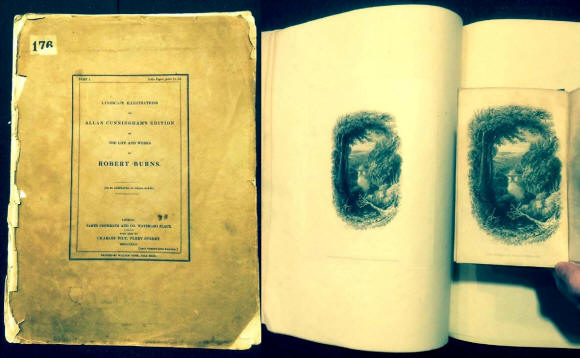
D. O. Hill, Landscape Illustrations to Allan
Cunningham’s edition (London, in parts, 1834-1835)
Cover for part 1 (left); “The Braes of Ballochmyle,” with the same image
from Cunningham, vol. II (right)
James Hogg’s edition had been planned
earlier, in 1831-32, but languished till Cunningham’s rival edition was
announced, when it was rushed to press. While the volumes were similar
in format to Cunningham (both were small octavos), the Hogg edition was
first issued in paper-covered parts, each of 144 pages, with an engraved
illustration. When it was announced, in January 1834, it was to be
edited by Hogg alone, and to consist of twelve parts, at 2 shillings
apiece, which would then also be available as five volumes, at 5
shillings each. The first part came out in March (and was reviewed in
The Scotsman on March 26), but sharp criticism in the London papers led
the publisher, Archibald Fullarton, to bring in William Motherwell as
coeditor, and it is now generally cited as “Hogg-Motherwell.”
Publication thereafter was irregular, with the final sections, parts
11-13, including Hogg’s Memoir of Burns, not published till 1836 (Egerer,
pp. 167-168). By then, both Hogg and Motherwell were dead. There is a
set of the original parts in the Mitchell Library, Glasgow, which shows
that the critical attack on the first number led to a ‘cancel’ or
substitute page before the edition was published in volume form (Fisher,
p. 27): in part 1 of the original issue (vol. 1, p. 125), Hogg’s note
about the subject of “The Lament occasioned by the Unfortunate issue of
a Friend's Amour,” which commented on Alexander Cunningham being jilted
by his “darling sweetheart” (“she acted a wise part. H.”) had to be
withdrawn, and a new note by Motherwell, linking the poem instead to
Jean Armour, was substituted.
When bound, the Cunningham and Hogg-Motherwell editions look very
similar, and they were competing for the same elegant, middle-class
market, but buying the Hogg-Motherwell edition required much less
disposable income. A full set of Cunningham would have cost forty
shillings or two pounds, and to keep up with the new volumes required
the ability to spend five shillings each month for six months, but a
full set of Hogg-Motherwell could be had for two thirds of the price,
and the part issue meant that purchasers need only fork over two
shillings at a time—manageable for many more people. For comparison, the
four volumes of the Currie edition (1800) had cost thirty-one shillings
and sixpence, and the three-volume Pickering (Aldine) edition (1839),
with just the poems, not the letters, cost fifteen shillings.
Most discussion of part publication stresses the importance for readers
of simultaneity, where publication of each part was a communal news
event, and a whole cohort of readers were all reading the same stage of
a serial publication at the same time, rather like people all watching
the same first-run television series. It was this simultaneity that gave
Dickens’s novels their enormous impact in early Victorian culture;
everyone had read the same stage of the story the same month, and no one
knew quite what would happen next. The part publication of Burns could
involve something of this (as for instance when a publisher advertised
that a new discovery would feature in the next number or when critics
responded to specific numbers of a work during publication), but because
most of the material in any Burns edition was already well known, the
sense of each installment as a special event or revelation played much
less of a role than in the serial publication of a novel. In fact,
another publishing development, stereotyping or the making of reusable
casts or plates of the typesetting, meant that both the Cunningham and
Hogg-Motherwell editions went on being reprinted again and again,
without revision, for many years after the original publication sequence
was over. While the Cunningham edition was soon also reformatted to make
a one-volume edition, and also soon pirated by other publishers (with
each resetting and pirating introducing some additions and revisions),
the Hogg-Motherwell edition was reprinted multiple times in its original
small quarto format from the same stereotype plates: Egerer records
reprints in 1835, 1836-41, 1838, 1840, 1848, and 1852. At least twice,
the edition was also reissued in parts: the Roy Collection has
part-issues, dated by the advertisements on the back covers, from the
1850s and amazingly the 1880s. Though they lacked the illustrations,
these reissues were even cheaper than the original: you could get the
reprinted part-issue in fifteen 120-page parts (each of 120 pages), at a
shilling a part, or in 30 60-page parts at sixpence a part.
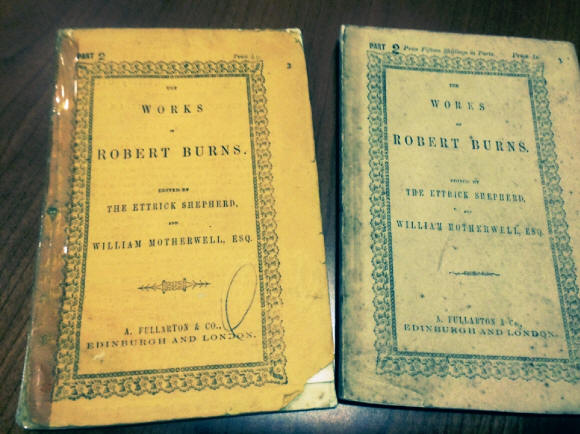
The later sixpenny and one shilling variant
reprints in the original format:
The Ettrick Shepherd and William Motherwell, The Works of Burns
(Glasgow, in parts, 1834-1836)
The third of the major Burns editions from
the 1830s was also published in several segments, if not formally in
part issue. This was Robert Chambers’s first version of what became,
through two later reworkings, the great Chambers-Wallace edition. As
Chambers and his brother William first published it, however, it
consisted of three works: Poetical Works, 1838; Life, 1838—an expansion
of Currie; and Prose Works, 1839—incorporating a lot of Cromek. The
parts were advertised as each being “complete in itself,” but they were
part of a series that W. and R. Chambers were publishing, first called
“The Standard Library,” but soon retitled “The People’s Edition.” The
Chambers brothers touted it as “The Cheapest Series of Publications Ever
Issued from the Press,” tall pamphlets on cheap paper, with
double-columns of cheap print. Other authors included Walter Scott (out
of copyright poetry only), Allan Ramsay, Francis Bacon, and William
Paley, and prices ranged from six pence up to two shillings, depending
on the length of the specific volume. The three parts could be bought
for 2 shillings, 1 s. 2 d., and 1 s. 10d, respectively, which meant the
complete Chambers Burns was only 5 shillings, an eighth the price of
Cunningham (advertisement in Caledonian Mercury, January 1, 1839).
Even in the early Victorian period, part-publication was still being
used to market more expensive large-format illustrated books. Full page
engravings or lithographs could not be printed in the same operation as
typeset material, and in some Victorian illustrated editions, the
illustrations take priority over the text. Sometimes, as the Cunningham
edition indicates, purchasers even wanted the illustrations by
themselves separate from the text. A good example of illustrations
taking priority is the two-volume collection, The Land of Burns, which
also had engravings by David Octavius Hill, along with text credited to
Prof. John Wilson (“Christopher North” of Blackwood’s Magazine), who
wrote the introductory essay, and by the ubiquitous Robert Chambers,
moonlighting for a publishing rival, Blackie and Son of Glasgow, who
provided descriptions of the landscape scenes and portraits. Wilson
dragged his feet, and Chambers’s text, and the illustrations, were
nearly finished and ready for publication before Wilson was shamed into
starting (Blackie, p. 39). The work was published both in a large-paper
version (40 cms in height), and in a still-impressive regular issue (27
cms.). Though the title page, and so most library catalogues, record the
publication date as 1840, it was actually published over a three year
period between November 1837 and November 1840, in 23 parts, at 2
shillings a part (Blackie, pp. 35, 114; cf. Egerer, p. 185). The Roy
Collection does not have any of the wrappered parts, but one of the
bound sets contains the giveaway sign previously mentioned that it has
been bound up from the part-issue: about a quarter-inch in from the
spine on each page is a line of several small pin-holes, indicating that
before the sections were stitched through the spine to form the book,
they had been “stabbed,” or stitched, through the pages, for
part-publication (cf. Dawson, p. 109). The old thread had been removed
in the rebinding, but the stab-holes remained. The same publisher
recycled many of the Hill illustrations again for a new edition of
Burns’s Works, again prefaced by Wilson’s essay (Egerer 450, p. 191).
This too was first issued in two shilling parts (this time 21 parts,
1842: Blackie, p. 115), before being issued in two volumes (1843, 1844).
For this edition alone Egerer lists eighteen reprintings. Blackie notes
that it was reissued in 1853 as 25 one-shilling parts, plus 8 additional
parts with the illustrations (Blackie, p. 117).
It should, by now, be no surprise to find that Robert Chambers’s next
Burns project, expanding and rearranging his edition of 1838-39 as a
four-volume edition, The Life and Works of Robert Burns (1851-1852), was
also first issued as separate parts, in blue printed paper wrappers, at
2s. 6d. each (cf. Egerer 540, p. 205). This was a price, and included in
a series (“Chambers’ Instructive and Entertaining Library. A Series of
Books for the People”), that would have justified simply reusing earlier
content, but Chambers had added quite a lot of further material, both
poems and letters. Chambers himself would revise it one more time, as
“the Library Edition,” again in four volumes, at 5 shillings each
(1856-1857: Gibson, p. 69; Egerer 594, pp. 216-217), adding a little new
material; this is the edition usually being cited as “Chambers” by
Victorian Burnsians before William Wallace overhauled it yet again for
the 1896 centenary.
But the editions described so far all pale in comparison with the two
great part-issues of Burns from the 1860s and 1870s. Both edited by
clergyman, the Rev. Dr. Peter Hately Waddell of Glasgow and the Rev. Dr.
George Gilfillan of Dundee, these were great big books that in volume
form had colorful heavily-gilt-stamped cloth bindings much like
Victorian family bibles. The involvement of ministers, even eccentric
ministers, and the respectable appearance of the series is significant
in a period when the unco guid were still often suspicious of Burns and
the Burns movement (cf. Whatley, pp. 87-92). Waddell’s edition even used
the same technology for illustrations, chromolithography and steel
engraving, that was often used for illustrated bibles, and in turn
publishers like Cassells were issuing family bibles in parts, so as to
expand the market by increasing their affordability. Waddell’s edition
is always dated from the title-page as 1867 (cf. Egerer 701, pp.
234-235), but in fact it was issued in large-format (magazine style)
parts, in vivid orange paper covers, over a period of 25 months (April
1867-April 1869).
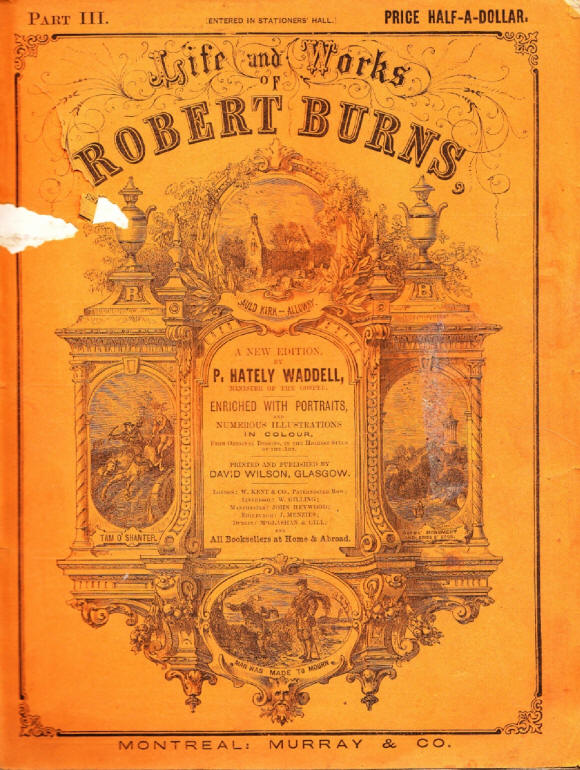
Cover of Part III of Waddell’s Life and
Works, Canadian issue (Montreal, [?1867])
Each 32-page part cost one shilling (more
for part 25, which was double the normal length), and each had a
full-page illustration, initially chromolithographs but later less
garish steel engravings. The parts did not consist of consecutive pages,
but each month offered groups of pages from different parts of the work.
It is also clear that, while the text itself was very carefully
prepared, Waddell improvised and added to his original plan, in the 110
page appendix, as correspondents wrote in with new biographical material
and anecdotes (cf. Scott, “The mysterious W.R.”). Robert Betteridge and
I have recently been disentangling this complicated story, which is too
complex to discuss fully here (but see Scott and Betteridge,
forthcoming). Waddell’s edition was widely advertised and enormously
successful, with a reported print-run of 20,000 copies a month.
Moreover, almost as soon as the part-issue was completed, the publisher
not only started selling the work in volume format, but started a second
two-year cycle of part-publication (1870-1872), this time with 26 parts
and with the pages in straightforward sequence. Earlier this year, I
chanced on a single issue from a hitherto-unrecorded Canadian part-issue
of the Waddell edition. Yet, as far as we can tell, of what must have
been hundreds of thousands of individual Waddell parts, only one set is
now recorded as surviving in original condition, in the National Library
of Scotland. The Roy Collection set, for instance, has been rebound, but
with the wrappers preserved, bound in at the back of the volume. Both
the NLS and Roy Collection copies also have a number of inserts or
advertising flyers drawing attention to special discoveries in that
month’s number.
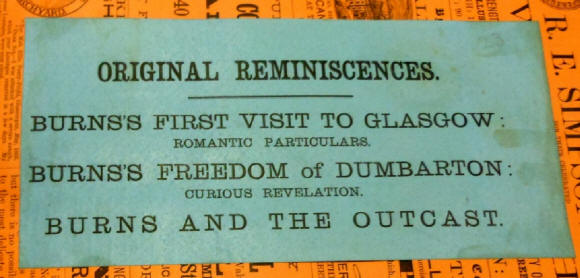
Advertising insert from Waddell’s Life and
Works, Part XXIII (February 1869) The
Gilfillan edition, the National Burns, used a very similar format and
marketing model to Waddell, but a much more straightforward arrangement, and no
signs of last-minute improvisation. The publisher, William Mackenzie of Glasgow,
had already issued one edition of The Complete Works of Burns in
1870-1871, in 17 parts, each of 32 pages with two engravings, at one shilling a
part; for that edition, the size and format was almost exactly the format that
Dickens had made famous for publishing his novels. Surprisingly, Mackenzie’s
1870-71 edition does not seem to be listed by Gibson or Egerer (but cf. Sudduth,
p. 126). To retain subscribers during the year and a half of publication,
Mackenzie had developed a shrewd marketing gimmick, promising that the last
seven parts would each have a small ticket printed on the back cover, and that
subscribers who mailed in the seven tickets would “receive for framing a Copy of
the Magnificent Portrait of Burns, after … Nasmyth,” which would be mailed
“carefully packed on a roller,” for which they had to pay another sixpence. At
least some purchasers took the bait, for the set in the Roy Collection has these
tickets duly snipped out.
The
editor, too, had been involved with a earlier Burns project. The Rev. Dr. George
Gilfillan (1813-1878), a Free Kirk minister and well-known literary critic, had
edited Burns in 1856 for a different publisher. For this new project, he
completed a new full-scale life, though he died before the edition began to
appear. The Gilfillan/Mackenzie National Burns gets only the briefest of
entries in Egerer, and Gibson in 1881 actually provided fuller information (Egerer,
799, p. 255; Gibson, p. 97). In book form, the title-pages of the two volumes
were dated 1879 and 1880, but it was issued first in fifteen parts, at two
shillings a part, and also in quarterly divisions at ten shillings and sixpence.
It was fully illustrated, with portraits of Burns and Jean Armour (and Gilfillan
himself), engravings of Burns’s homes, illustrations to the poems (mostly
engravings in the text, rather than printed separately), music or at least the
airs to the songs, a facsimile of Burns’s handwriting, and a picture of the
Burns Monument at Alloway.
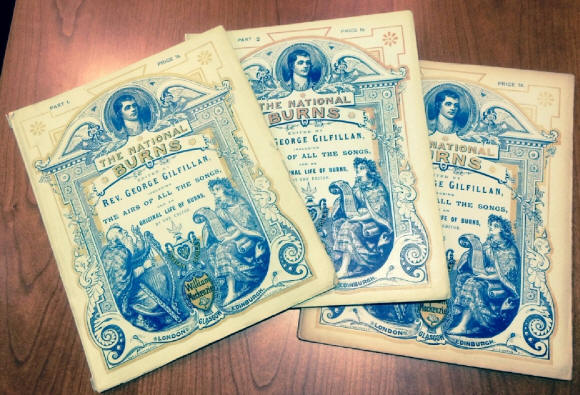
Wrappered parts from George Gilfillan’s The
National Burns (1879-1880)
Given the number of competing editions then
available, the challenge for Mackenzie was not just to publish, but to
market and sell, his new collected Burns. Once again, subscribers who
stayed the course were entitled to a “Life-Size Portrait of BURNS,” this
time after the drawing by Skirving. The Roy Collection has a related
item that casts light on his marketing efforts. This was a specimen or
“salesman’s dummy” that contained samples of a part-issue cover, and
sample pages, together with a sample of the gilt-stamped cover for the
edition in volume form. Such samples, much lighter to carry than the
books themselves, were often used by publishers’ sales representatives
when visiting bookshops in other towns or cities, but they were also
convenient for agents going door-to-door trying to sign up subscribers.
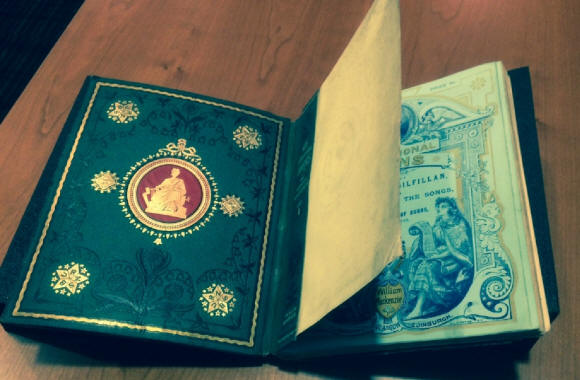
Salesman’s dummy for Gilfillan’s National
Burns, showing wrappers for the part issue and gilt-stamped cloth for
the volume binding.
A few years ago, Bill Dawson gave the Roy
Collection a rather similar salesman’s dummy for the Henley-Henderson
Centenary Burns. However, this was put together only after the edition
had been completed. It includes extracts from reviews as well as sample
contents and binding, but it does not offer the option of subscribing to
a part-issue.
The last major new Burns edition to be issued in parts seems to have
been William Wallace’s full-scale revision of the earlier Chambers
edition, which was published in book form in four volumes in 1896, with
several subsequent reprintings. I was in fact surprised to find that
Chambers-Wallace, unlike its chief late Victorian rivals, the Scott
Douglas and Henley-Henderson editions, was available in 22 blue-wrappered
parts, each of 96 pages, published at two weekly intervals, at a cost of
one shilling a part. This differs from earlier examples of part-issue,
in that the parts were not released in advance of publication in book
form; they are a straight printing from the same sterotype plates as the
volumes, though with narrower page margins. Because the editing and
typesetting was all complete before part 1 hit the bookstalls, not still
a work-in-progress, it could be issued with a part every two weeks,
rather than monthly or at irregular intervals. It is worth noting that
the title-page for the first volume occurs at the beginning of part 1,
rather than the title-pages and prelims coming at the end of the final
number, just in time for rebinding, as was more usual for part
publication. Moreover, while the book form was available in a special
limited large-paper version, the part-issue was clearly a much more
humdrum production, so much so that it goes unmentioned in Egerer (cf.
Egerer 893, p. 271 ff.). It did, however, include the same illustrations
as the more formal version.
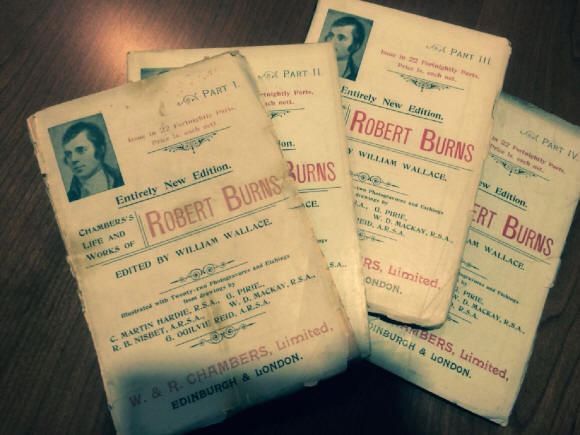
The Chambers-Wallace Life and Works of
Robert Burns (1896), in parts
The Chambers-Wallace part-issue also,
however, highlights the way serial publication might increase the
pleasure of reading a new Burns edition, by its format, not just through
commentary or illustrations. By the 1890s, the sheer amount of material
by and about Burns that was available to editors had grown inexorably.
Sitting down to read one’s way through the four fat volumes of
Chambers-Wallace, with the six volumes of Scott Douglas already looming
on the shelves, and a dim consciousness that Henley and Henderson’s
small-print textual notes if studied closely contained much new
information, would seem burdensome. The big late Victorian editions are
imposing on the shelf, eloquent symbols both of a commitment to the
Bard, and of one’s own income and respectability, but more Burnsians,
then and now, will have bought them, maybe dipped into them and set them
aside, or looked something up, than ever read them cover to cover to
cover. By contrast, with its convenient 5 x 8 ¼ inch magazine-like
format, one can imagine commuters snapping up each new slim installment
from the station bookstall on publication day to read on their journey
home, with the promise of more, but not too much more, to read over the
weekend. At least in format, Chambers-Wallace in parts was competing,
not with the illustrated family bibles of the 1860s, but with the latest
Conan Doyle in the Strand magazine.
Part-publication, then, represents an important aspect of the
nineteenth-century Burnsian experience. It is not surprising that an
antiquarian bookdealer would not have encountered them. The set my
longtime friend described in his email, a late example published just
before the First World War, represents the staying power of this
publishing mode well after its heyday. Though few libraries now preserve
even sample parts, publication in that format was in fact widespread.
I’d be happy to hear from any collectors fortunate enough to own further
examples.
References
W. G. Blackie, Sketch of the Origin and Progress of the Firm of Blackie
& Son, Publishers, Glasgow, from its Foundation in 1809 to the Decease
of its Founder in 1874 ([Glasgow]: printed for private circulation,
[1897]).
Bill Dawson, “The First Publication of Burns’s ‘Tam o’ Shanter’,”
Studies in Scottish Literature, 40 (2014): 105-115: and in Burns
Chronicle for 2016, 125 (November 2015), 15-25.
J. W. Egerer, A Bibliography of Robert Burns (Edinburgh: Oliver and
Boyd, 1964)
Joe Fisher et al., Catalogue of the Robert Burns Collection, The
Mitchell Library, Glasgow (Glasgow: Glasgow City Libraries and Archives,
1996).
[J. Gibson], The Bibliography of Burns (Kilmarnock: James M’Kie, 1881).
G. Ross Roy, and Patrick Scott, “A Conversation with G. Ross Roy,” Burns
Chronicle Homecoming 2009, ed. Peter J. Westwood (Dumfries: Burns
Federation, 2010), 414-424.
Patrick Scott, “The Mysterious ‘W.R.’ in the First Commonplace Book,”
Burns Chronicle for 2016, 125 (November 2015), 8-14.
__________ and Robert L. Betteridge, “The Part Issue of Hately Waddell’s
Life and Works of Robert Burns,” forthcoming.
Elizabeth Sudduth, The G. Ross Roy Collection of Robert Burns, An
Illustrated Catalogue (Columbia, SC: University of South Carolina Press,
2009).
Christopher Whatley, Immortal Memory: Burns and the Scottish People.
(Edinburgh: John Donald, 2016). |

